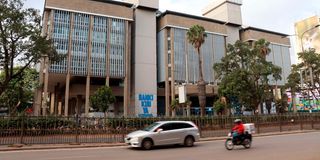CBK deters banks with six-year- high emergency loan rate

The Central Bank of Kenya, Nairobi. The next leadership of the Central Bank of Kenya (CBK) must ponder and wade through the assignment to sharpen deliverables, given the worsening economic conditions and a tradition of bank balance sheets tight-fisted with loans.
The interest rate at which commercial banks borrow from the Central Bank of Kenya (CBK) has risen to a six-year high, pointing to an effort by the regulator to discourage lenders from taking excessive risk in the hope that it would come to their assistance with emergency credit.
The latest data shows the CBK discount window rate increased to 15.5 per cent on March 29—the highest since March 19, 2018, and an increase from 13 per cent at the start of the year.
The CBK runs a “discount window” from which banks can tap funds as a last resort after exhausting all other avenues, including borrowing from one another.
Transactions here occur through reverse repos, which are commonly used by the CBK to advance short-term capital to other businesses during cash-flow challenges.
They involve the purchase of government securities by the Central Bank from commercial banks.
According to CBK Annual Report 2022, it lent banks Sh91.86 billion in the year ended June through emergency support tools such as rediscounting Treasury bills and bonds, deposits and repurchase agreements (Repos)— treasuries cashed at the CBK with a promise to buy them back in future.
The amount included Sh20.04 billion as an impairment allowance set aside by CBK, an indication that the banks being supported were becoming riskier.
The loans had grown from Sh75.51 billion in the year ended June 2021, including an impairment allowance of Sh15.97 billion. This has been a jump from Sh67.2 billion lent as of June 2020.
Borrowing from the regulator through the discount window facility is often seen as an indication that the appropriating bank is desperate for money and cannot get it from other banks in the interbank market—putting them at risk of a fallout with investors and depositors.
The jump in the rate comes when liquidity in the market has thinned, indicating that banks could be resorting to CBK support in the market.
The rate at which banks lend to each other –interbank rate- jumped to 8.4594 per cent on April 13, four years and eight months high since August 6, 2018, when it was recorded at 8.7321 per cent.
This comes amid tightened liquidity in the market due to a rise in base lending rates and subsequent short-term government securities rates as banks are forced to attract larger depositors to keep their money with them instead of lending to the State.
The tight liquidity is on the back of a hike in the base lending rate to the highest level in five years to curb inflation.
The central bank rate (CBR) increased to 9.50 percent in March from 8.75 percent.
High returns on short-term government securities signal a preference for lending to the State even by large corporations and high-net-worth individuals, which would attract higher yields than the banks’ deposit rates.
The tight liquidity is on the back of surging inflation and low firms’ revenues creating a growing pool of distressed borrowers in the economy and risking to increase defaults.
This has been a stretch from the impact of the Covid-19 period and prolonged political uncertainty in the wake of the disputed presidential vote which slowed economic activities.





